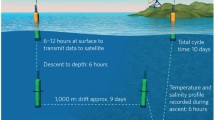Abstract
A Seasat-A Project was conceived and is being implemented to establish the utility of an array of microwave instruments in space for oceanic research and marine technology. The instruments include: a short-pulse radar altimeter, a wind-field scatterometer, an experimental synthetic-aperture imaging radar, a scanning multifrequency microwave radiometer, and a supporting visual and infrared radiometer. All weather, day-night measurements of sea-surface temperature, surface wind speed and direction, sea state and directional wave spectra will be made, the latter over limited areas and times because of operational limitations on the synthetic-aperture-radar instrument. Highly precise (&<0.1 m) range information from the radar altimeter, in combination with an accurate satellite emphemeris, will be used to infer dynamic departures of sea level from the marine geoid produced by tides, currents, and storm surges. Sea ice will be observed by the synthetic-aperture radar, radar altimeter and the scanning multifrequency microwave radiometer, with particular emphasis on demonstrating their capability to determine polar ice coverage, dynamics and navigability.
The satellite will be launched into a high-inclination (108 °), non-sun-synchronous, nearly-circular 800 km orbit in May of 1978. The orbit is such that a dense network traced out by the subsatellite point (18.5-km equatorial separation of ascending orbits) will be obtained in 152 days for geodesy. The satellite is designed for a minimum lifetime of one year; with expendables, including orbit adjust capability, for three.
All data, except those obtained from the synthetic-aperture radar, will be collected globally, and returned, as measured, first by a 25 kbps data stream, and then after playback at a rate of 800 kbps from the on-board tape recorder. Synthetic-aperture radar data will be returned in real time only, over a 20-MHz analog telemetry link. We expect that satellite data will be distributed through the National Oceanic and Atmospheric Administrations Environmental Data Service. Processed data are expected to be generally available through this agency within a very few months of launch, following preliminary assessment of instrument operation and evaluation of performance.
Similar content being viewed by others
References
Apel, J. R., (Ed.): 1972, ‘Sea Surface Topography from Space’, Vols. 1 and 2, Tech. Rep. ERL 228, Nat. Oceanic and Atmos. Admin., Boulder, Colo. U.S.A.
Apel, J. R. and Byrne, H. M.: 1974, ‘Oceanography and the Marine Geoid’,Applications of Marine Geodesy, Marine Technology Society, Washington,. D.C., p. 59.
Apel, J. R. and Siry, J. W.: July, 1974, ‘A Synopsis of Seasat-A Scientific Contributions’,Seasat-A Scientific Contributions, NASA, Washington, D.C.
Apel, J. R.: 1976, ‘Ocean Science from Space’,Trans. Amer. Geophys. Union 57, 612–624.
Barncastle, L.: 1971, ‘ITOS Meteorological Scanning Radiometer’,Proc. Electro-Optics '71 West, 164.
Brown, W. E., Jr., Elachi, C., and Thompson, T. W.: 1976, ‘Radar Imaging of Ocean Surface Patterns’,J. Geophys. Res. 81, 2657.
Campbell, W. J., Weeks, W. F., Ramseier, R. O., and Gloersen, P.: 1975, ‘Geophysical Studies of Floating Ice by Remote Sensing’,J. Glaciol. 15, 305–328.
Cardone, V. J. and Pierson, W. J.: 1975, ‘The Measurement of Winds over the Ocean from Skylab with Application to Measuring and Forecasting Typhoons and Hurricanes’,Proc. Eleventh Int. Symp. on Space Techn. and Sci., Tokyo.
Dunne, J. A.: 1976, ‘The Seasat-A Project: An Overview’,Oceans 76 Conference Record, p. 10A-1.
Gloersen, P. and Salomonson, V. V.: 1975, ‘Satellites: New Global Observing Techniques for Ice and Snow’,J. Glaciol. 15, 373.
Gloersen, P. and Barath, F. T.: 1976, ‘The Seasat-A Scanning Multichannel Microwave Radiometer’,Oceans '76 Conference Record, p. 10C-1.
Grantham, W. L., Bracalente, E. M., Jones, W. L., Shrader, J. H., Schroeder, L. C., and Mitchell, J. L.: 1975, ‘An Operational Satellite Scatterometer for Wind Vector Measurements over the Ocean’, NASA Tech. Memo X-72672, Goddard Space Flight Centre, Greenbelt, Md.
Grantham, W. L. and Jones, W. L.: 1976, ‘The Seasat-A Microwave Scatterometer’,Oceans '76 Conference Record, p. 10D-1.
Hendershott, M. C., Munk, W. H., and Zetler, B. D.: July 1974, ‘Ocean Tides from Seasat-A’,Seasat-A Scientific Contributions 54, NASA, Washington, D.C.
Jones, W. L., Schroeder, L. C., and Mitchell, J. L. 1976, ‘Aircraft Measurements of the Microwave Scattering Signature of the Ocean’,IEEE Trans on Antennas Propag. AP-25, 52–60 (in press).
MacArthur, J. L.: 1976, ‘Design of the Seasat-A Radar Altimeter’,Oceans '76 Conference Record, p. 10B-1.
Marsh, J. G., Lerch, F. J., and Vincent, S. F.: 1973, ‘The Geoid and Free Air Gravity Anomalies Corresponding to the Gem-4 Earth Gravitational Model’,NASA/Goddard Space Flight Center Rept. S-592-73-58, Greenbelt, Md.
McGoogan, J. T., Leitao, C. D., and Wells, W. T.: 1975, ‘Summary of Skylab S-193 Altimeter Altitude Results’, NASA Tech. Memo X-69355, Goddard Space Flight Center, Greenbelt, Md.
McGoogan, J.: 1975, ‘Satellite Altimetry Applications’,IEEE Transactions on Microwave Theory and Technology MMT-23, (12), 970–978.
Miller, L. S. and Brown, G. S.: 1974, ‘Engineering Studies Related to the GEOS-C Radar Altimeter’,NASA CR-137462.
NASA, Wallops Flight Center: 1974, ‘GEOS-C Mission Plan’,Wallops Flight Center Rept. TK-6340-001, Wallops Island, Va.
Pierson, W. J., Cardone, V. J., and Greenwood, J. A.: 1974, ‘The Applications of Seasat-A to Meteorology’, NOAA/NESS/SPOCTechnical Report, Grant No. 04-4-158-11, The University Institute of Oceanography, City University of New York.
Ross, D. B. and Cardone, V. J.: 1974, ‘Observations of Oceanic White Caps and Their Relation to Remote Measurements of Surface Wind Speed’,J. Geophys. Res. 79, 444.
Thompson, T. W., Brown, W. E., and Elachi, C.: 1976, ‘The Seasat-A Imaging Radar’,Oceans '76 Conference Record, p. 10E-1.
Walsh, E. J.: 1974, ‘Analysis of Experimental NRL Radar Altimeter Data’,Radio Sci. 9, 711.
Author information
Authors and Affiliations
Rights and permissions
About this article
Cite this article
Dunne, J.A. The experimental oceanographic satellite Seasat-A. Boundary-Layer Meteorol 13, 393–404 (1978). https://doi.org/10.1007/BF00913884
Received:
Issue Date:
DOI: https://doi.org/10.1007/BF00913884




